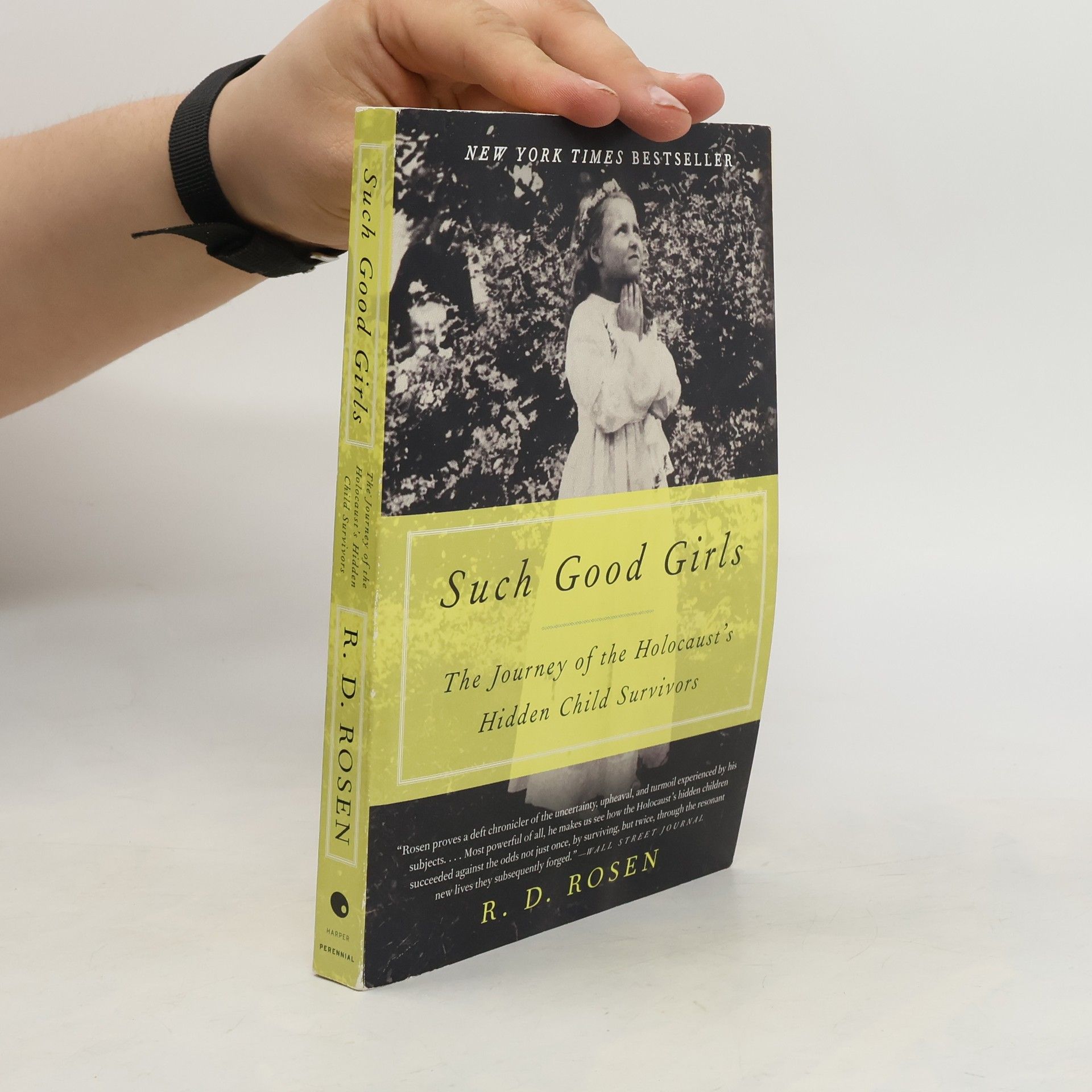Na osudech tří židovských dívek – z Polska, Holandska a Francie – autor otevírá téma židovských dětí, které přežily druhou světovou válku v úkrytech. Dočteme se o polské Židovce Sophii, které spolu s její matkou zařídil jejich otec falešné doklady a rodné listy prokazující křesťanský původ. Sám krátce poté zmizel a rodina o něm už nikdy neslyšela; matka tak s malou Sophií zůstala sama a v neustálém strachu z prozrazení přežily celou válku. Díky tomu, že hovořila německy, pracovala jako písařka u místního SS důstojníka, který ani netušil, že zaměstnává Židovku. Malou Floru odložila matka nejprve do kláštera, a když i tento úkryt začal být příliš nebezpečný, putovala holčička do bezdětné rodiny francouzsko-švédských manželů, kteří byli chráněni švédskou ambasádou. Malou Carlu zase spolu s její matkou ukrýval holandský holič. Kniha se věnuje i tematice vlivu dětských traumat na život v dospělosti obecně: v kariéře, navazování vztahů, ale i v psychické vyrovnanosti a povědomí o vlastních kořenech.
Richard Dean Rosen Knihy







Numbers play a meaningful role in the philosophy of many spiritual traditions—and yoga is no exception. For example, the number one is the quintessential yoga number, representing “unity” and “wholeness”; number two sometimes stands for co-operative effort, and other times for conflict; and number four is the number of completeness or stability, as it “stands” on “four legs.” There are twelve different names for the mantra OM, each one revealing a different aspect of this root sound.With his distinctive blend of knowledge and humor, Richard Rosen unpacks the fascinating significance that numbers hold in the philosophy and practice of yoga. Stories and practices woven throughout—like the Eka Danta simple meditation exercise, which concentrates on "one pointedness" and is associated with the one tusk of Ganesh—offer readers a hands-on way to explore the importance of numbers in their own practice. Yoga by the Numbers will enlighten and entertain the yogi in your life.
Pranayama beyond the Fundamentals
- 224 stránok
- 8 hodin čítania
For serious students of yoga who have an established pranayama practice, this book is a follow-up to Rosen’s previous book, The Yoga of Breath. Here he picks up where he left off, offering a selection of traditional yogic techniques for those who wish to deepen their practice of pranayama and their understanding of the ancient wisdom of yoga. Rosen skillfully puts forward an array of awareness disciplines, breathing practices, mudras, and seals, interspersed with anecdotes and quotes from ancient texts.A free audio program available online offers a variety of guided practices so that listeners can create their own pranayama series, with guidance from the author in the appendix. (Download instructions available in the book.)
A comprehensive overview for professionals working with traumatized children, which outlines the theory and practice of life story therapy, a method which helps children and cares to question and resolve issues and events within a child's life.
Such Good Girls
- 304 stránok
- 11 hodin čítania
"The real-life puzzle of what happened to the generation of Jewish children who survived the Holocaust in hiding, Edgar Award-winning mystery novelist R. D. Rosen tells this silent, forgotten generation's story through the lives of three girls hidden in three different countries--among the less than 10 percent of Jewish children in Europe to survive World War II--who went on to lead remarkable lives in New York City"-- Provided by publisher
Convergence Marketing
- 272 stránok
- 10 hodin čítania
Offering a common language, better processes, and a set of practical tools, Convergence Marketing is a real-world guide that successfully combines the best of brand and direct into something more powerful and effective than either can be on its own. Convergence marketing offers the kind of real-time accountability that positions marketing as a vital and effective component of leadership's overall business strategy. Convergence brings brand and direct together with respect to both disciplines, within the same silos. And it offers the necessary tools and processes that deliver better results. Our global market demands nothing less than this fully integrated approach. Convergence Marketing is the key to shifting marketing communications efforts from a cost-based to a profit-driven model and will have your CFO begging you to spend more money.
The Yoga of Breath
- 320 stránok
- 12 hodin čítania
Discover the basics and benefits of breath control—pranayama—and how to incorporate it into your yoga practiceFor several thousand years, yogis have drawn on the powerful practice of pranayama, a technique of controlling the breath to maximize prana or life energy. Pranayama has been practiced to rejuvenate the body and as a means of self-study and self-transformation. While most yoga practitioners today focus on asanas , or body postures, a growing number of people are learning the complementary practice of pranayama to deepen and enrich their practice. The Yoga of Breath is a guide to learning the fundamentals of pranayama and incorporating them into an existing yoga practice. Rosen's approach is easy to follow with step-by-step descriptions of breath and body awareness exercises accompanied by clear illustrations. The book also covers the history and philosophy of pranayama, offers useful practice tips, and teaches readers how to use props to enhance the exercises.
Part history, part philosophy, part yoga instruction manual, this book clears up some of the confusion and misconceptions about the development of yoga, both traditional and modern. Richard Rosen draws from ancient yoga manuals, which combine philosophy with postures and meditations, to show how traditional practice compares with what we do today. He is an engaging, experienced guide who reveals the development of modern yoga through the centuries and shows how the ancient yogis did it. Each section offers a guided practice session of ancient poses and breathing techniques to enable readers to connect to the roots of their yoga and to provide a framework for understanding the sequences they use in their regular sessions.
As baby boomers pass age 50, problems with knees, ankles, and backs are leading them into lower-impact forms of fitness. The stress of career and later-in-life children also have them seeking new ways to relax. Combine these pressures and it is no surprise that yoga is increasing in popularity among the 50-plus crowd. Tailored specifically for this burgeoning population, 50+ Yoga offers a straightforward approach that makes it easy to learn yoga at any age. The book's adaptable program allows readers in good shape to experience a challenging workout, while people with physical limitations benefit from gentler postures, breathing exercises, and meditation practices. Throughout the book, the author focuses on the needs of older beginning students, providing tips for moving comfortably into a pose, avoiding injury, and using helpful props, such as chairs, foam blocks, and cotton straps. The author details the basic principles of yoga and teaches the common elements of all postures and movements: alignment, breath, and awareness. However, the vast majority of the book is devoted to teaching the yoga poses through the use of step-by-step photos, clearly written instructions, and helpful hints from the author.
Mercy Killing and Other Tall Meisehs
- 224 stránok
- 8 hodin čítania
Exploring the complexities of Jewish life, this collection delves into the myriad rules found in the Torah, Talmud, and rabbinical writings. It presents a blend of real and imagined scenarios, showcasing how traditional laws apply to various circumstances, some of which are unlikely to occur in reality. The stories challenge readers to consider the implications of these ancient teachings in both plausible and fanciful situations, offering a thought-provoking perspective on the intersection of faith and everyday life.